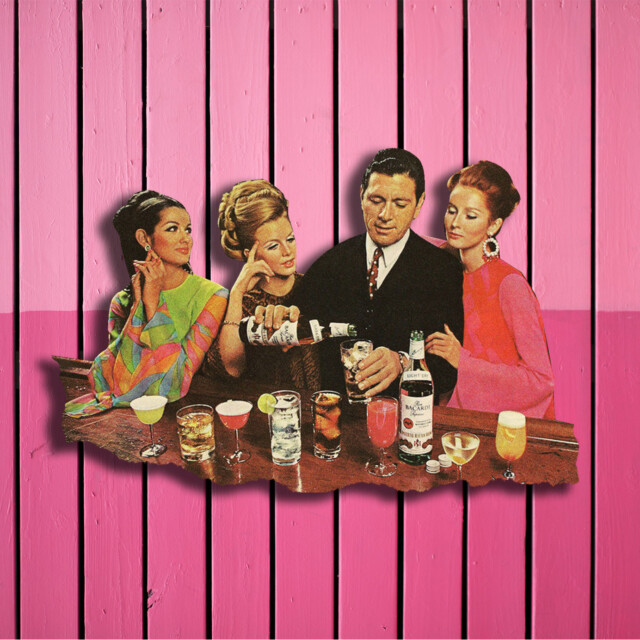For many people, the holidays are synonymous with the season of giving. But for those who love to host and entertain, this festive time of year means just one thing: cocktail parties and swanky holiday soirées. The allure of a glamorous night of boozy drinks, dapper attire, and Champagne served in coupe glasses is hard to ignore. And as December begins, it only seems fitting to ponder how this elegant drinking ritual began.
Some sources credit British novelist Alec Waugh as the inventor of cocktail parties following an article he penned for Esquire about hosting the first party in 1924. But more sources point to 1917 and Clara Bell Walsh, a Kentucky-born heiress and New York socialite known for throwing lavish parties with exclusive guest lists. On one spring day in April 1917, Walsh threw her most legendary soirée to date, which would etch her name in history as the creator of the cocktail party.
But was Walsh’s gathering really the first of its kind? Surely imbibing events such as this had occurred before. After all, mixed alcoholic drinks such as punch date as far back as the 1600s, not to mention that Jerry Thomas published the official cocktail guide more than 50 years earlier, in 1862.
While Thomas’s guide can be seen as the first dedicated cocktail book, it provided no decor advice nor etiquette tips for throwing a party focused entirely on drinking. For that, Walsh and many other women relied heavily on other writings found in the newspapers of the day.
A New Era
According to Elizabeth Pearce, drinks historian and founder of Drink & Learn, an interactive experience and guide to cocktails in New Orleans, the “Women’s Section” in newspapers provided domestic advice, including food and drink recipes. As talk of Prohibition gained steam, due to the efforts of the temperance movement, American drinking culture began to shift from the saloon to the home. “At that time, cocktail culture was something that took place outside the home, but with Prohibition looming all that changed, and there was a strong emphasis on women learning to host and entertain with alcohol at home,” Pearce says.
Although Prohibition didn’t begin until 1920, Americans knew it was coming. “With the 18th Amendment banning only the manufacture, sale, and transportation of alcohol, and not the consumption or even possession of it, many people began to stockpile liquor with the intent to consume it at home,” Pearce says. (On a now famous occasion, silent actress Charlotte Hennessey Smith bought the entire contents of a liquor store and had it delivered to her home for the dry months to come.)
At this same time, the “New Woman” era arose, bringing forth independent women challenging the boundaries of a male-dominated society. The feminist ideal bid adieu to domestic traditions, such as long, multi-course formal dinners, and instead favored more casual get-togethers. Interestingly enough, despite Prohibition, newspapers continued to market the necessary accouterments for preparing drinks and hosting in their women’s sections during this time.

With the combination of drinks advice from domestic publications, the closures of bars, and the emerging freedom of feminism, women everywhere were poised to take cocktail culture into their own hands. “Given the time, most women were used to having guests over for dinners, or tea, but the notion of hosting an event focused around cocktails comes about because of Prohibition,” Pearce says.
While it’s likely that other parties were occurring around this time, somehow Walsh’s took the cake.
Who Was Clara Walsh?
Born in Kentucky in 1884, Walsh grew up in the spotlight of her wealthy father. Though he died when she was 8, he entrusted her with a fortune that would ensure her place in society and fund her busy social life.
In her adult years, Walsh went on to marry a wealthy man from St. Louis and, more notably, became one of the first residents of the Plaza Hotel in New York City. Her life in New York was a whirlwind of extravagant parties and she was no stranger to hosting them or being in the spotlight. In fact, Walsh was often featured in prominent publications such as The New Yorker and Esquire, which deemed her the “First Lady of the Plaza.”
But her most notable mention came from a local Washington newspaper, “The Tacoma Times.” On April 17, 1917, the publication dubbed one of Walsh’s grand affairs a “cocktail party” and declared them the new “stunt” of society.

The article praises Walsh’s innovation. “Positively the newest stunt in society is the giving of ‘cocktail parties,’” it says, and gives readers a glimpse into Walsh’s first affair: “The party scored an instant hit. Mrs. Walsh’s home is equipped with a private bar. Around this the guests gathered and gave their orders to a white coated professional drink mixer who presided behind the polished mahogany.”
The revolutionary gathering took place at her father-in-law’s home in St. Louis and placed Walsh as the epitome of the modern woman — sophisticated, independent, and a cocktail drinker not shy about her desires. Though Prohibition would slow the occurrence of future cocktail parties, Walsh’s contribution to cocktail culture would not be forgotten.
Today we remember Walsh as the mixing maven who gave us the thrill of lavish gatherings fueled by glamor and drinks. This year, as you’re toasting to the season, why not raise a glass to the woman who started it all, Mrs. Clara Bell Walsh?
